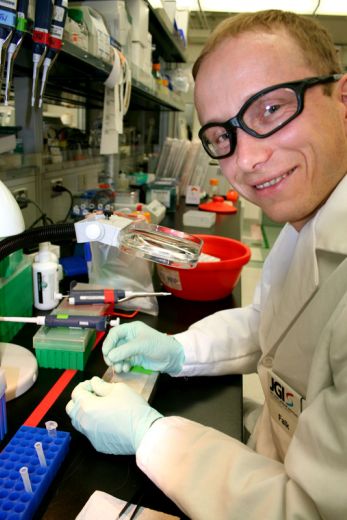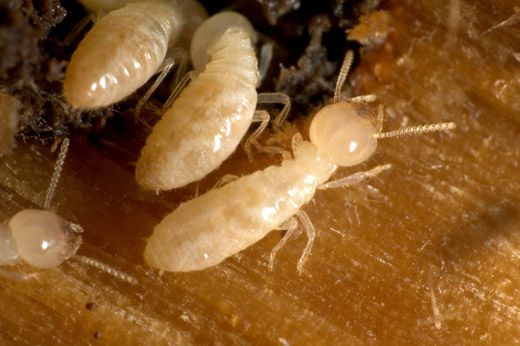Termite Bellies and Biofuels
Scientist Falk Warnecke’s research into termite digestion may hold solutions to our energy crisis
/https://tf-cmsv2-smithsonianmag-media.s3.amazonaws.com/filer/termites_aug08_631.jpg)
Falk Warnecke peered down through a mounted magnifying glass and poked gently at a small pile of bugs. They were dead—frozen and heaped on a chilled metal block like coffee grounds mounded on a spoon. With a pair of fine-tipped forceps, he grabbed one of the insects at the base of its thorax and lifted it off the block. It was brown, and hardly bigger than an eyelash. With a second forceps, he pinched the end of its abdomen. He tugged gently, and pulled it in two. A shiny, reddish string slid smoothly out of the exoskeleton. Warnecke smiled. "That's a good thing about termites," he said with a thick German accent. "You get the whole gut in one piece."
Warnecke doesn't want the termite's plumbing to get torn and its contents mixed around. It's the contents he's interested in. The gut has bulbous chambers that are swollen with vast quantities of microbes that the termites employ to break down cellulose from the wood or grass the insects consume. When he's not calling termites "cute little animals," he refers to them as "walking bioreactors," and considers their juicy interiors a kind of liquid gold. For now, he's interested only in the biggest bulb on the string, what's known as the third proctodeal segment, or, in the vernacular of microbial ecology, the "hindgut paunch." This microliter-sized compartment—much larger than the surrounding gut sections and easily distinguished with the naked eye—is home to a distinct community of microbes that some people think may help solve the energy crisis.
Warnecke, a researcher at the U.S. Department of Energy's Joint Genome Institute in Walnut Creek, California, has been generating lots of attention lately for his work with termites. The insects are remarkably efficient at turning cellulose into sugar—the first step in making fuel from plants like switchgrass or poplar trees. Scientists can't compete with termites. They can break apart cellulose's tough bonds in the lab, but the enzymes they use are wildly, prohibitively expensive. That's where Warnecke comes in. His research has some people salivating at the prospect of dipping into the termites' microbial stew and pulling out a few enzymes that would finally make it possible to produce ethanol from cellulose on an industrial scale.
Laying aside the forceps, Warnecke picked up two long needles and pushed away the termite's limbs and carapace. He put a drop of buffer solution on the gut to keep it moist and then proceeded to attack the bulging hindgut paunch, repeatedly stabbing the shiny bulb until its contents spilled out and mixed with the buffer to form a slurry of enzymes and cellulose fragments. With his pipette, he sucked up some of the liquid "mash" and squirted it into a plastic tube. He hopes to identify the cellulose-degrading enzymes in the mash, but he first has to figure out which gut-dwelling bacteria make them, and which ones actually work at digesting cellulose.
On weekday mornings when the weather is good, Warnecke bikes to the BART train and takes it from Berkeley through the hills to the upscale suburb of Walnut Creek. At the train station he hops back on his bike and pedals a couple of miles past tidy strip malls and gas stations to Joint Genome Institute's verdant, industrial-park-like campus. The DOE opened the institute in 1997 to serve as the center of the Human Genome Project, which deciphered the sequence of base pairs in our DNA The project ended in 2003, but JGI remains a global hub of genome sequencing and mapping work. Inside the building's branching maze of labs and offices nearly a hundred washing machine-sized sequencing machines sit humming, awaiting DNA and RNA samples sent here for analysis by scientists around the world.
Warnecke, who earned his PhD at the Max Planck Institute for Marine Microbiology in Bremen, Germany , has acquired an even more rarefied expertise in Walnut Creek. He's part of a small band of microbiologists who've left their agar plates for a relatively new field known as metagenomics, which involves analyzing DNA directly from environmental samples, like termite guts or a spoonful of ocean surface water, instead of from cultivated cells.
"Microbiologists have probably always suspected they were missing some diversity," said Warnecke. In the early days of genome sequencing, scientists grew a single type of microorganism at a time, then extracted and sequenced DNA from those cells. To them, sucking a random collection of microbes right out of a termite's belly and hoping to sequence and sort each individual bacteri um's genetic material would have seemed downright audacious, if not impossible.
Warnecke, who at 35 looks like a fresh-faced Vladimir Putin, considers himself an explorer at the lab bench. What pricks up the hairs at the back of his neck is the search for novel enzymes—a charting of new, and very, very small, territories. " It's like being the first person to see butterflies, " he says.
Shifting on his lab stool, Warnecke began to settle into the process he'd spend the rest of the day finishing. He readjusted his safety glasses and latex gloves, picked up another termite, and started the degutting process all over again. This termite, a Nasutitermes corniger, was brown like the others and had a shiny, ribbed abdomen. Its eyeless, round head had two pincers sticking out from the top. Termites in the genus Nasutitermes feed on dry dead wood. This one, before it was frozen and shipped here from Florida, had been a worker, a member of the caste charged, in part, with finding and processing cellulose to feed a nest's soldiers and reproductive royalty.
Nasutitermes is a genus close to Warnecke's heart. A metagenomic study he did with the genus in 2007 uncovered a trove of new information about what goes on inside the insects' bellies. Not only did he and his colleagues discover previously unknown enzymes, but they also confirmed that in the class of so-called "higher" termites, hindgut-dwelling bacteria synthesize those enzymes—merely a speculation before Warnecke's study. That work garnered him first-authorship on a paper in the prestigious journal Nature. After that came a flurry of media interest, lecture requests, and now a $240,000 grant from the Energy Biosciences Institute—UC Berkeley's new biofuel venture with BP—to spend the next two years further exploring termite guts, this time with three different grass-fed species.
Warnecke's relationship with termites has the mark of a genial obsession. On weekend walks through Tilden Park in the Berkeley hills, Warnecke slips sticks and handfuls of soft forest litter into his pockets. He takes the debris back to his apartment and sprinkles it into a terrarium, home to a few hundred termites he's collected from the California wild. These insects are not for splitting apart, but simply to care for. "I don't really know what to feed them," he said, "but I think they are happy." Warnecke is a dutiful curator of the tiny; he serves small organisms and their microscopic inner seas.
In the lab, Warnecke swept up a pile of now-thawed termite bits with his hand and tossed them into a biohazard bin . He'd finished degutting his first set—fifty per tube—and went to retrieve a fresh collection from the freezer on the other side of the room. He is violent with them, but his affection for termites is obvious. His work's green energy potential, however, leaves Warnecke mostly unmoved. He'll happily debate biofuel feasibility, but says the topics don't animate him.
He opened the new tube of termites and poured a small pile onto the metal block. He'd fly the next day to Europe to give a round of talks on his termite work to academics eager to be on the forefront of cellulose-degradation research. "It's nice to have an applied aspect and I hope it will be a useful contribution," said Warnecke, seeming a bit weary of all the excitement. "But I'm first of all interested in the basic science, the microbial diversity and the symbiosis." Then he picked up another termite, and split it in two.

